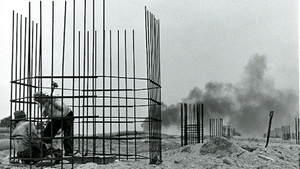Stay in the Loop
BSR publishes on a weekly schedule, with an email newsletter every Wednesday and Thursday morning. There’s no paywall, and subscribing is always free.
Reflecting Philadelphia's past in hand-made mirrors
Hand-Made Mirrors: The photography of Philip Taylor at Temple University

The longer you’ve been in Philadelphia, the more Philip Taylor’s photographs resonate. Now 91, Taylor has spent his adult life taking pictures of his world, which, except for military service and travel, is here. He recently donated his work to Temple University, where a selection of images is on view at the Samuel L. Paley Library.
Taylor fell for photography while working as a lithographic cameraman at Mid-City Press, where he made half-tones and color separations. He taught himself darkroom technique, and was rarely without a camera.
Though Taylor continued to work in commercial printing and never made his living at photography, it became the focus of his life.
Technically, he was an amateur, but Taylor didn’t shoot the usual suspects. In Hand-Made Mirrors, there are no clichéd vacation shots, snaps of the cat, or backyard barbecues. He simply pointed his camera at what interested him, creating a visual diary for anyone who cares to look.
A vanished urban frontier
In the mid-1950s, on Philadelphia’s extreme southeastern edge, in a region known as “The Neck,” a neighborhood called Stonehouse Lane was about to be displaced by the Walt Whitman Bridge. Taylor documented the bridge construction, and made some of the last images of the idiosyncratic neighborhood, which was built on a marsh, rimmed in canals, and inhabited by small farms and tenant families who lived even then without running water and sewers. Stonehouse Lane was an urban frontier, with the emphasis on frontier.
Taylor’s idyllic photos look nothing like South Philly now, and maybe not then either: You can see the horizon. Boys swing from trees on ropes as a freight train passes in the distance. One half-expects Huck and Jim to float into the frame on their raft. But by 1956, the dreamy landscape was buried under access roads, and stadiums would soon populate that horizon.
Some issues persist
Taylor also spent time in the Tenderloin and Skid Row districts, as photographer for a Quaker Friends Neighborhood Guild project to address tuberculosis among Philadelphia’s transient population. The area in question — roughly bounded by Seventh and 11th streets, and Spring Garden and Arch — is now occupied by Chinatown and the Pennsylvania Convention Center. Tuberculosis was a scourge here, with more than 9,000 cases ocurring in 1950 alone, and was concentrated in in poor, crowded inner-city neighborhoods.
The homeless occupy many of Taylor's photographs. In the earliest, down-on-their-luck men appear in white shirts and dark slacks, meeting the camera’s gaze. In one 1953 image, a neatly dressed man enters a rooming house. It could be any hotel, until you notice that the attendant sits behind a protective screen, upon which hangs a sign listing the room price: 35 cents. It's a more nostalgic view of homelessness than we're used to seeing. But a picture Taylor made on a New Year's Day 40 years later, at Fifth and Arch Streets, is instantly, sadly, recognizable: A huddled mass curling over a sidewalk steam grate, keeping warm.
Downashore and beyond
Like all good Philadelphians, Taylor went down the shore. Some of these prints depict the timeless beauty of beach grass shadows on the sand, or the arc of the shoreline, but others are poignant reminders of Atlantic City in better, pre-casino days, when families saved up for a stay at the Dennis or Traymore Hotel, and dressed up for dinner at Captain Starn’s restaurant.
Ranging farther, Taylor photographed Cuba as the island nation fastened its hopes on Fidel Castro. Instead of focusing on the late-1950s revolution, though, he shot everyday life: surfers, and a man posing with a machete in front of a tall apartment building.
There is no theme to the exhibition, which wanders over three levels of Paley Library, other than Taylor’s perspective over a lifetime of taking pictures — what he thought worth shooting. It’s a personal view conveyed through impersonal subjects — unknown men playing bocce on a South Philadelphia dirt road, an anonymous woman washing clothes in her backyard 30 miles off the coast of Florida. It’s a reminder that everyday images gain value as the inevitable present becomes the unattainable past.
What, When, Where
Hand-Made Mirrors: The Photography of Philip Taylor. Through August 2016, at Temple University Samuel L. Paley Library, 1210 Polett Walk, Philadelphia. (215) 204-2828 or http://library.temple.edu.
Sign up for our newsletter
All of the week's new articles, all in one place. Sign up for the free weekly BSR newsletters, and don't miss a conversation.